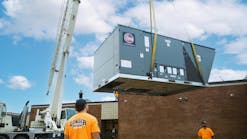May 8, 2024 -- At the perimeter of any construction site, you will find large fences designed to keep construction materials in and danger out. But those aren’t the barriers that keep more people from joining the construction workforce.
Virginia Tech researchers say it’s the invisible barriers that need to be deconstructed. While many in both industry and academia tout best practices to recruit and retain a more diverse crew, Myers-Lawson School of Construction researchers have found the “perfect answer” doesn’t exist — yet.
“A lot of companies present what they're doing as a best practice, and yet in some cases, they don’t even know if it works within their own organization because the data isn’t there,” said Josh Iorio, assistant director for Myers-Lawson. “There's a ton of space here for improvement.”
With more than a decade of experience at Virginia Tech, Iorio has seen efforts to grow the construction industry in many shapes and sizes. In 2014, he began to join the university’s InclusiveVT efforts. During that time, he coordinated a speaker series, poster projects, and mentorship programs to boost knowledge about diversity and inclusion in construction education. But in the industry, he heard stories of women being treated differently, people being harassed, and racial slurs.
“I'm sitting across from parents with concerns about their daughter going into the industry. Initially, I told them things were changing and getting better and that's the old industry, but I didn't know,” said Iorio. “I saw it as being unethical to basically say things are getting better without any evidence."
Iorio said that honesty set him on a path to take a real look at representation in the industry. Through years of leading inclusion and diversity efforts within the school of construction, Iorio saw a further disconnect between industry and academic efforts. Both acknowledged problems such as a lack of women, a lack of a diverse and robust workforce, and low retention rates, but there was little to no research about how to fix the problems.
Merging theory and practice
Enter building construction Assistant Professor Alireza Shojaei. While the majority of his work is focused on revolutionizing the construction industry through digital innovation, he also seeks to innovate hiring and retention practices using data.
“This work is personal for me. I lived in three different countries on three different continents and saw firsthand the impact and the importance of working with people from different backgrounds and different societies,” said Shojaei.
Shojaei sees workforce challenges as complex issues involve economics, social sciences, and political initiatives. He and graduate student Mohammad Hossein Heydari are taking an in-depth look at the individual pieces of the bigger puzzle. Their first deep dive focused on the areas where academic leaders offered ideas for potential best practices.
Their research found several scholars offering suggestions for an industry standard including
- Female mentorship or role model programs
- Increasing the number of women in managerial positions
- Unifying communication practices
- Flexibility in work-life balance
- Transparent promotion criteria
- Return-to-work training for new mothers
- Sharing success stories
Based on those suggested measures, they then looked at the last 13 years of construction labor data from the U.S. Bureau of Labor Statistics for indications of whether those ideas translated into noticeable changes within the construction industry. Combining the qualitative data from the literature and the quantitative data from the labor statistics, they uncovered trends that pointed them toward future exploration:
- Women make up roughly 11 percent of the workforce, but 50 percent of the population. They are by far the most studied group. Efforts have been made to increase the number of women in the workforce, but so far, the data trends do not indicate significant growth.
- Female students outside of construction programs mention the industry's poor image as a deterrent, even in some cases where they have family ties to construction.
- When women are on a job site, there tend to be lower accident rates and higher safety performances, but it’s not known if one causes the other.
- There is a high rate of injury among Hispanic workers in construction. While many say this is caused by a communication issue, the researchers found that it is only one of many factors including higher productivity pressures, poor safety climates, and supervisor pressures.
- There is limited information about other ethnic groups, LGBTQIA+, and people with disabilities. Researchers say it’s not because those sections of the population are not in the construction industry, but rather a hesitation to self-report due to external fears or pressures.
“The research over time is increasing, but not fast enough to generate the knowledge we need to be able to solve the problems that we've identified. We need a concerted effort between the people whose job it is to conduct research and the people whose job it is to recruit and retain within construction,” said Iorio, who is serving as the connection point between construction industry executives and researchers. “What we found is that there aren't any obvious best practices, right? That's the punchline.”
Data can unlock solutions to help both individual companies and the industry as a whole, but that data needs to come from the companies themselves, which requires buy-in and transparency.
“Hopefully, what comes of this is that the industry will see there's still a lot of work to be done. The researchers need access and support from those in the industry. We don't need all of your data, but rather specific kinds of data so that we can prove some of these theories that we're presenting here,” said Iorio.
With specific data, the researchers could investigate subfactors that affect recruitment and retention within companies including location, sector of construction, safety, company policies, profits, and more. The research team recently added graduate students Hossein Naderi and Reachsak Ly to review industry articles and journals for similar suggestions about best practices.
“We need to talk to people; we need to conduct surveys, collect data, and see if we can connect these policies to the results that we are seeing and see what is and is not effective,” said Shojaei.
Partnership for industry progress
The researchers found companies are hesitant to provide data due to fears of being judged or facing consequences. With over a decade of work in this area, Iorio is helping companies dismantle those fears through transparency. In 2021, he began to host “elephant in the room" discussions to bring together people who work on inclusion and diversity efforts within their own companies. There, the group had honest conversations about the issues and potential solutions that exist across the spectrum.
“The future of the industry is focused on smart construction and technology. But if we don't have people, there's no industry of the future,” said Iorio. “This type of work takes time and money, both of which are valuable resources for a company’s bottom line. What we want to offer is research-backed inclusion and diversity models that have tangible results so companies can invest in the best areas to yield the best results.”
Over the years, Iorio has worked closely with several companies that believe in this vision for the future of the industry, including construction management consulting firm MBP and its co-founder and CEO, Blake Peck. He has seen the industry change over many decades and envisions a partnership with the research team as a pathway for more people to enter the industry and keep the story of this dynamic industry alive.
"We have a great story here in the construction industry, but we unfortunately keep it a secret," said Peck. “I hope this research sheds light on the great work we do, our desire to increase representation and the importance of implementing strategies and processes that are specifically designed for the rewarding and dynamic nature of construction.”
In the long run, researchers hope these efforts not only elevate the experience of current industry workers, but open more doors for a new generation of leaders. This summer, Shojaei and his team plan to publish a knowledge database to give people a chance to access the available data.
Contact: Chelsea Seeber | [email protected] | 540-231-2108
Caption: Students stand at perimeter of jobsite during classroom tour. Photo by Peter Means for Virginia Tech.
Online Link: https://news.vt.edu/articles/2024/05/eng-construction-workforce-research









